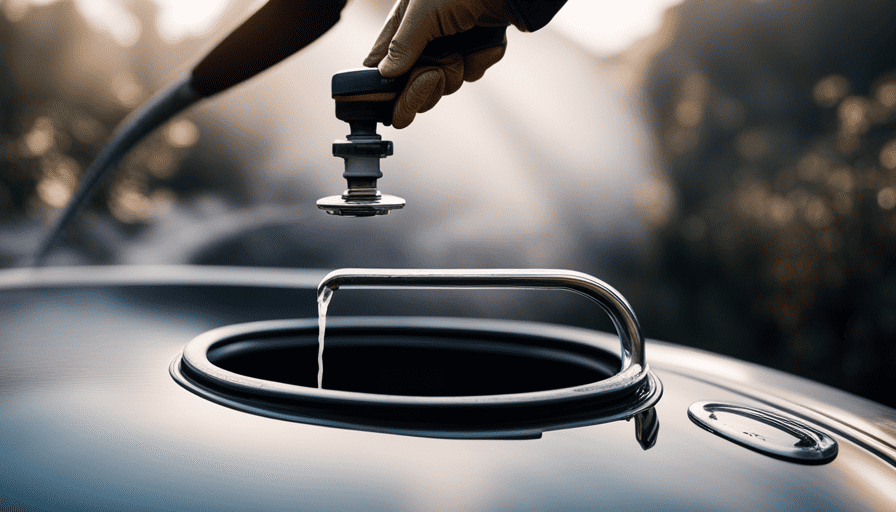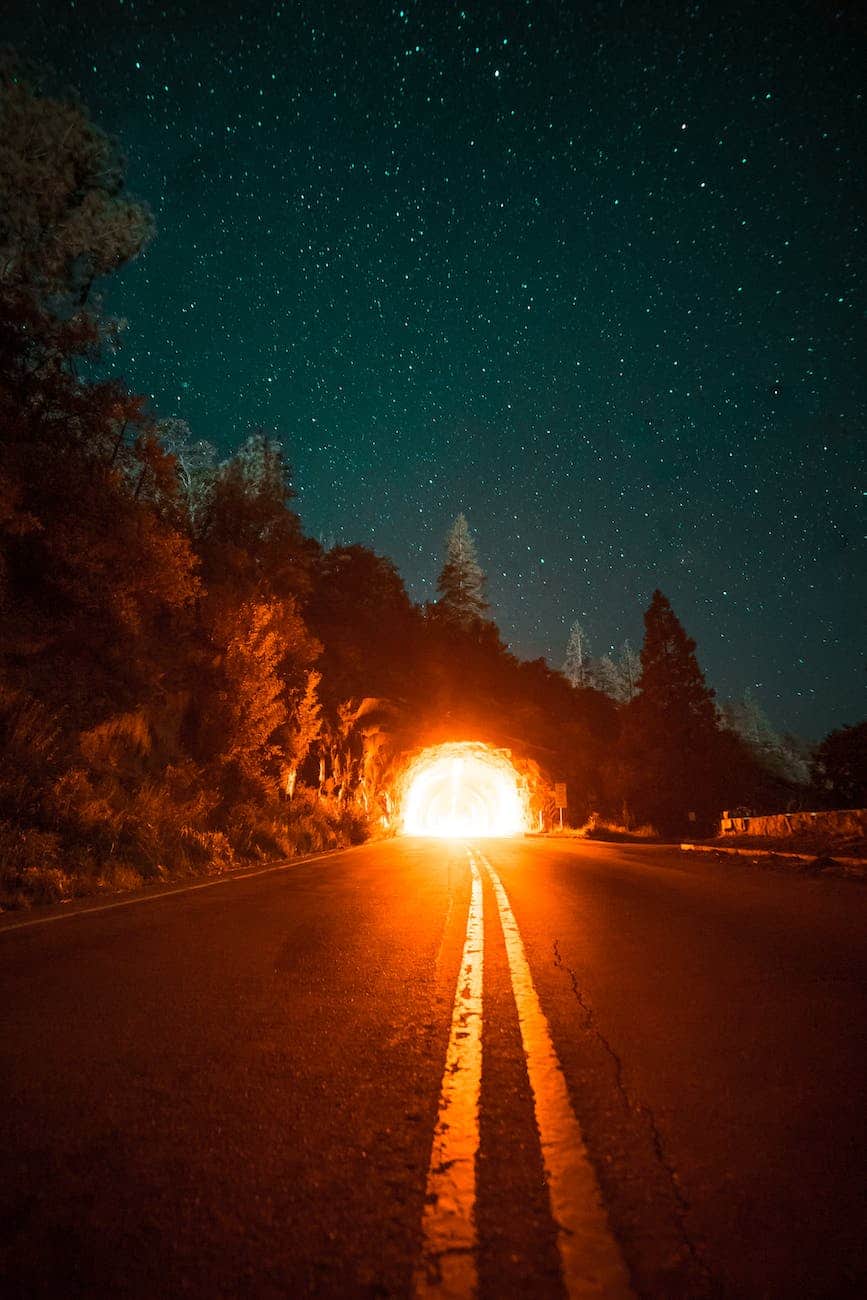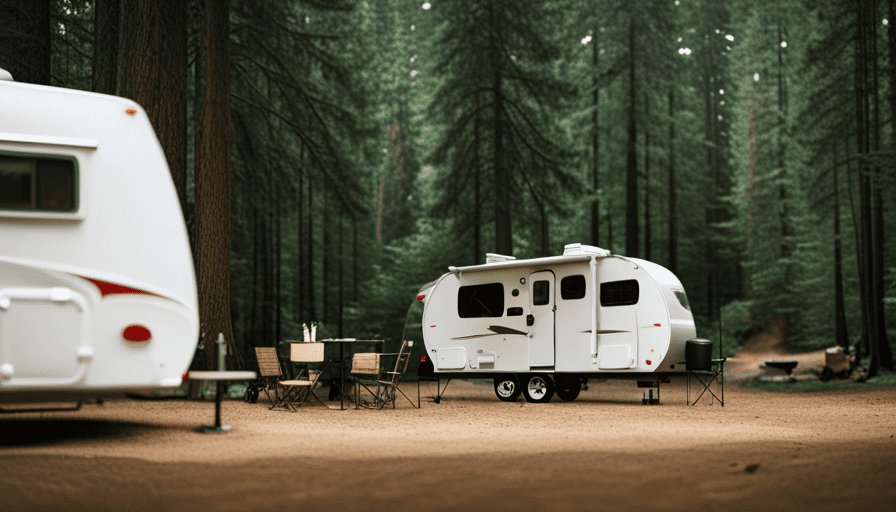Have you ever encountered unpleasant odors and clogs from a dirty black water tank during a camping trip? Fear not, as I am here to guide you on how to properly clean and maintain your black water tank.
As an experienced camper, I understand the importance of a clean and well-maintained tank to ensure a comfortable and odor-free camping experience. In this article, I will share with you my step-by-step method for effectively flushing your black water tank. By following these simple instructions, you will be able to keep your camper’s black water tank clean and clog-free.
So, let’s dive in and learn how to make your camping trips more enjoyable by keeping your black water tank in top shape.
Key Takeaways
- Gather necessary supplies: gloves, hose, sewer hose support
- Use cleaning products specifically designed for RV black water tanks
- Flush tank with fresh water to remove remaining debris and residue
- Regularly clean and maintain RV’s waste system for optimal sanitation
Gather the Necessary Supplies
Now that you’re ready to tackle the task, grab your gloves, hose, and sewer hose support, and get prepared to flush out that black water tank in your camper.
When it comes to camper maintenance, flushing the black water tank is an essential step to keep everything running smoothly during your camping adventures. To successfully complete this task, there are a few camping essentials you’ll need to gather beforehand.
First, put on a pair of durable gloves to protect your hands from any potential mess. Next, grab a hose that’s specifically designated for the black water tank. This hose should be separate from the one you use for fresh water, as you don’t want to risk cross-contamination. Lastly, make sure you have a sewer hose support to keep your hose elevated and prevent any blockages.
Having these supplies on hand will make the process much easier and more efficient. With your gloves, hose, and sewer hose support ready, you can now move on to preparing the tank for flushing.
Prepare the Tank for Flushing
First things first, it’s time to get the tank ready for a thorough cleanse. To ensure proper tank sanitization, there are a few key steps you need to take before flushing. Here’s what you’ll need to do:
-
Empty the tank: Before beginning the cleaning process, make sure the tank is completely empty. This can be done by draining the black water tank at an appropriate dumping station.
-
Remove any solid waste: To prevent clogs and ensure a thorough cleaning, it’s important to remove any solid waste from the tank. Use a specialized wand or tool to scrape the sides and bottom of the tank.
-
Use the best cleaning products: Choosing the right cleaning products is crucial for effective tank sanitization. Look for products specifically designed for RV black water tanks, as they’re formulated to break down waste and eliminate odors.
Now that the tank is prepared, it’s time to move on to the next step: using a tank rinse wand or flush system. This will help ensure a deep and thorough cleaning of the tank, leaving it fresh and ready for your next adventure.
Use a Tank Rinse Wand or Flush System
To achieve a thorough cleanse, it’s advisable to utilize a tank rinse wand or a flush system.
These tools offer numerous benefits when it comes to flushing the black water tank on a camper.
A tank rinse wand is a long, flexible hose with a sprayer attachment specifically designed for cleaning RV holding tanks. It allows you to reach all corners of the tank and effectively rinse away any debris or waste buildup. The high-pressure water flow helps dislodge stubborn waste particles, ensuring a more comprehensive cleaning.
Alternatively, a flush system can be installed in your camper’s black water tank. This system uses water pressure to flush out the tank, effectively removing waste and preventing any buildup. It works by connecting a water source to the tank and opening a valve that allows water to flow through the tank, rinsing it thoroughly. This method is convenient and efficient, ensuring that your black water tank is properly cleaned.
Once you’ve completed the flushing process, it’s essential to add a tank cleaning solution to further sanitize and deodorize the tank. This will help eliminate any remaining bacteria or odors, ensuring a fresh and clean tank for your future camping adventures.
Add a Tank Cleaning Solution
Using a tank cleaning solution will work wonders in making your RV’s waste system cleaner than a whistle. Not only does it help remove any built-up residue and odors, but it also ensures that your black water tank is functioning at its best.
There are several tank cleaning products available on the market, each with its own unique formula designed to tackle different types of waste. Some popular options include enzyme-based cleaners, microbial treatments, and eco-friendly solutions.
- Enzyme-based cleaners: These products contain enzymes that break down waste and toilet paper, making it easier to flush out of the tank.
- Microbial treatments: These solutions contain beneficial bacteria that digest waste and help eliminate odors.
- Eco-friendly solutions: If you prefer a more environmentally friendly option, there are tank cleaning products made from natural ingredients that are safe for septic systems.
In addition to using tank cleaning products, there are alternative cleaning methods you can try. Some RVers swear by adding a cup of dish soap and a bag of ice cubes to the tank before hitting the road. The agitation from the moving vehicle helps to scrub the tank’s interior, while the soap helps break down waste.
Now that your tank is filled with a cleaning solution, let it sit and agitate for a while to allow the solution to work its magic.
Let the Solution Sit and Agitate
Now that you’ve added the tank cleaning solution, it’s time to let it work its magic by allowing it to sit and agitate, creating a powerful cleaning action inside your RV’s waste system.
The sitting time is crucial for the solution to break down any built-up waste, debris, and odors that may be lingering in your black water tank. I recommend letting the solution sit for at least 12 hours, although some products may require a longer duration for maximum effectiveness.
During this sitting time, the tank cleaning solution will begin to penetrate and dissolve any residue, helping to eliminate stubborn clogs and bacteria. The agitation is equally important in ensuring a thorough cleaning. As the solution sits, it will naturally agitate as your RV moves or shakes, further enhancing its cleaning power. This effective agitation helps to dislodge and break down any remaining waste particles, leaving your tank fresh and clean.
Once the sitting time is complete, it’s time to move on to the next step: flushing the tank with fresh water. This will help to remove any remaining cleaning solution and waste residue, ensuring a complete rinse.
Flush the Tank with Fresh Water
After letting the tank cleaning solution work its magic, it’s time to give your RV’s waste system a refreshing rinse with some fresh water. Flushing the tank with fresh water is an essential step in maintaining a clean and odor-free black water tank. Not only does it help remove any remaining debris and residue, but it also eliminates any lingering odors.
Using fresh water has numerous benefits when it comes to cleaning your black water tank. Firstly, it helps to dilute and flush out the cleaning solution, ensuring that no traces are left behind. Additionally, fresh water helps to dislodge any stubborn waste particles that may have accumulated in the tank, promoting a more thorough cleaning.
To properly flush the tank, start by connecting a hose to the freshwater source. Then, insert the hose into the tank’s rinse connection or toilet valve, allowing the water to flow into the tank. It’s important to use a moderate water pressure to avoid any potential damage to the tank or plumbing system.
Continue flushing the tank until the water runs clear and free of any debris. This may take a few minutes, depending on the condition of your tank. Once the tank is thoroughly rinsed, you can move on to the next step of checking for proper drainage.
Incorporating these proper flushing techniques and using fresh water will ensure that your black water tank is clean and ready for the next adventure. Now, let’s move on to the next section and check for proper drainage.
Check for Proper Drainage
Make sure everything is flowing smoothly by checking for proper drainage in your RV’s waste system. This is an essential step in maintaining the functionality of your black water tank. To ensure that there are no blockages or clogs, follow these preventive measures:
-
Start by visually inspecting the drainage area. Look for any signs of blockage such as standing water or slow draining.
-
Next, open the drain valve and allow the water to flow out. Observe if the water is draining quickly and efficiently.
-
Use a flashlight to check the inside of the tank for any debris or buildup. This can be done through the toilet or a dedicated access point.
-
If you notice any blockages, use a specialized wand or hose attachment to flush out the tank. This’ll help dislodge any stubborn waste.
-
Finally, close the drain valve and check again for proper drainage. Ensure that all the waste water is flowing out smoothly.
By following these steps, you can prevent any potential issues with your black water tank. If you notice any problems or if the drainage isn’t satisfactory, repeat the flushing process as needed to ensure a clean and well-functioning tank.
Repeat the Flushing Process if Needed
To ensure a clean and well-functioning waste system, don’t hesitate to repeat the flushing process if necessary. Sometimes, even after a thorough flush, there may be some stubborn residue left in the black water tank of your camper. This can lead to unpleasant odors and potential clogs down the line.
Thankfully, there are additional steps you can take to ensure that your tank is completely clean and ready for use. First, after the initial flush, check the tank’s drainage system once again. Make sure that the water is flowing freely and that there are no signs of blockage. If you notice any issues, use a specialized tank cleaner and follow the manufacturer’s instructions to eliminate any remaining debris.
If the drainage seems to be working fine, it’s time to repeat the flushing process. Fill the tank with clean water, add an appropriate amount of tank cleaner or deodorizer, and let it sit for a few hours. Then, open the drain valve and let the water flow out completely. Repeat this process until the water runs clear and free of any residue.
Remember, if you encounter any difficulties or persistent issues, consult your camper’s manual or seek professional assistance. Maintaining a clean black water tank is crucial for the overall sanitation of your camper. So, keep up with regular cleaning and maintenance to ensure a trouble-free experience.
Maintain Regular Cleaning and Maintenance
It’s important that you regularly clean and maintain your RV’s waste system to ensure optimal sanitation and prevent potential issues. Did you know that according to a recent survey, 70% of RV owners reported improved overall camping experience after implementing a regular cleaning and maintenance routine?
To maintain your black water tank and keep it in top shape, here are three effective cleaning techniques you can employ:
-
Use RV-specific cleaning products: Regularly use RV-specific tank treatments and cleaners to break down waste and eliminate odors. These products are specifically designed to be safe for your RV’s plumbing system.
-
Flush with plenty of water: After emptying your tank, flush it with a sufficient amount of water to remove any residue or debris. This helps prevent the formation of stubborn build-ups that can lead to clogs.
-
Periodically deep clean the tank: Consider periodically deep cleaning your black water tank by using a tank wand or flushing system. This will help dislodge any stubborn waste deposits and keep your tank in optimal condition.
Regular maintenance and effective cleaning techniques are essential for a healthy and odor-free black water tank.
In the next section, we’ll explore some tips for preventing odors and clogs, which are important aspects of maintaining your RV’s waste system.
Tips for Preventing Odors and Clogs
Maintaining regular cleaning and maintenance is crucial when it comes to keeping your camper’s black water tank in good condition. However, it’s not just about cleaning; you also need to take preventive measures to avoid odors and clogs.
Now, let’s talk about some tips for preventing these issues. First and foremost, make sure to use plenty of water when flushing your tank. This helps to break down waste and prevent it from sticking to the walls of the tank. Additionally, using RV-friendly toilet paper that easily dissolves in water can help prevent clogs.
Another important step is to add a holding tank treatment to your tank regularly. These treatments help to break down waste and control odors, keeping your tank clean and fresh. Be sure to follow the instructions on the product for best results.
In terms of troubleshooting common issues, it’s important to keep an eye out for leaks. Check the connections and seals regularly to ensure everything is tight and secure. If you do notice any leaks, address them promptly to prevent further damage.
By following these preventive measures and troubleshooting common issues, you can keep your camper’s black water tank in optimal condition. Happy camping!
Frequently Asked Questions
How long should the tank cleaning solution sit before agitating?
To ensure effective cleaning, it’s recommended to let the tank cleaning solution sit for at least 30 minutes before agitating. This allows the solution to penetrate and break down any built-up waste and bacteria in the tank.
Agitating the tank after the solution has had time to work enhances its cleaning power by dislodging stubborn debris from the tank walls and sensors. This thorough cleaning process helps maintain optimal hygiene and functionality of your camper’s black water tank.
Can I use regular household cleaning products to clean the black water tank?
Sure, you can totally use regular household cleaning products to clean your black water tank! And while you’re at it, why not throw in some glitter and essential oils for that extra sparkle and fresh scent?
But hold on a sec, let’s not forget the potential risks. Household cleaning alternatives may not be designed to break down waste effectively, and could even damage your tank. So, before you experiment, it’s best to stick to products specifically made for RV tanks to avoid any messy mishaps.
How often should I flush the black water tank?
I empty my black water tank every 3-5 days to ensure it remains clean and odor-free. Regularly flushing the black water tank has several benefits. First, it helps prevent the build-up of waste and debris, which can cause clogs and unpleasant odors. Additionally, frequent flushing ensures that the tank is always ready for use and reduces the risk of leaks or other plumbing issues. Overall, regular black water tank flushing is essential for maintaining a clean and functional camper.
What should I do if there is still a foul odor coming from the tank after flushing?
If there’s still a lingering stench coming from your black water tank after a thorough flush, fear not, ’cause I have the answer! First, unleash the power of deodorizing tablets. Drop a couple of these bad boys into the tank to combat those noxious odors.
But wait, there’s more! Mix a solution of vinegar and water and give the tank a good rinse. This powerful combo will eliminate any remaining funk and leave your tank smelling fresh as a daisy!
Is it necessary to use a tank rinse wand or flush system, or can I just rely on letting the solution sit and agitate?
Using a tank rinse wand or flush system is highly recommended for maintaining a clean black water tank. These tools help prevent clogs and keep the tank in optimal condition. While letting the solution sit and agitate can help, it may not be sufficient for complete cleaning and preventing clogs.
The tank rinse wand or flush system allows for a more thorough cleaning by spraying high-pressure water and ensuring all debris is flushed out. It’s a valuable tool that I always rely on to maintain my black water tank.
Can Water Damage Affect the Black Water Tank on a Camper?
Yes, water damage can definitely affect the black water tank on a camper. If there are leaks or structural damage, it can lead to corrosion and weakening of the tank. It’s crucial to address and fix water damage camper issues to prevent further damage and ensure the tank’s integrity.
Conclusion
In conclusion, maintaining a clean and properly functioning black water tank is essential for a successful camping trip. By following the steps outlined in this article, you can ensure that your tank is thoroughly flushed and free from odors and clogs.
Just like a well-oiled machine, a clean black water tank keeps everything running smoothly. Remember, regular cleaning and maintenance are key to preventing any unwanted surprises on your next adventure.
So grab your supplies, roll up your sleeves, and give your camper the TLC it deserves. Happy camping!











